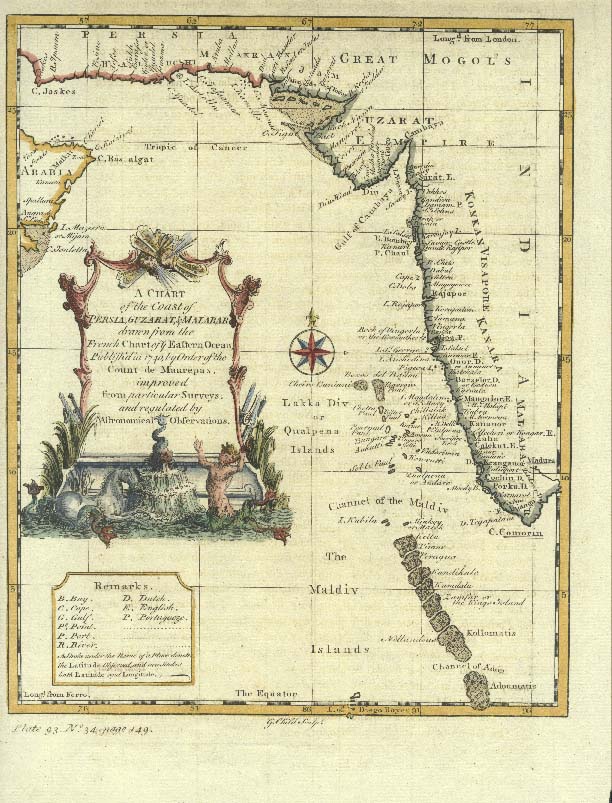Hanuman and the Pallimaradi
A timely question from my friend Nikhil about the Zamorin’s flag prompted me to revisit this study. Recently, an image of a flag appeared online, featuring a design with crossed swords, a conch, and a lamp, which claimed to be the Zamorin’s flag. I am not convinced, as I haven't seen such an image or description in any Zamorin-related documents I have studied so far. In fact, the only mention is that Udhhanda’s poem on Calicut’s Manvikrama referenced a tiger (sardula) symbol in this context, although some argue it was a misinterpretation of the poem, written shortly after leaving the Chola country (It is well known that the tiger was a Chola flag symbol). Anyway, let’s explore the topic a bit and see where it leads us.
Why does an army need a flag during its march and subsequent
battles? Usually, a flag serves as a symbol of identification, loyalty, and
unity, acting as a rallying point for soldiers and a sign of solidarity. The
Zamorin’s army had been moving continuously from the 1400s to the 1700s,
fighting Valluvanad, Cochin, and the Portuguese, as well as battling the Dutch,
Travancore, and, of course, the Mysore forces. Some sources mention that a
younger Eralpad (second in line to the Zamorin), who often led or commanded
these battles, carried a flag with the Hanuman symbol. We also know from
another record that the Zamorin took with him the ceremonial Cheraman sword,
the same one damaged in a fire, during a battle against the Dutch VOC at
Kodungallur. There are no reports of a flag with the sword, conch shell, and
lamp, though at least two of these are ceremonial items linked to the Zamorin.
Out at sea, we know that the Marakkar fleet of the Zamorin flew flags, but
strangely, no descriptions of them have been recorded by any Portuguese scribe.
Hanuman’s image
However, a more thorough search uncovered a flag associated
with the Zamorin, which displayed an image of a god or goddess, in
Waldseemüller's Carta Marina, sheet 8. Martin Waldseemüller's Carta Marina,
published in 1516, is a significant world map that expands on his earlier work
from 1507. Unlike his 1507 map, the Carta Marina introduced a new layout,
rejecting the Ptolemaic model and other previously used sources. It included
descriptive text, numerous illustrations, and reflected Portuguese explorations
of the Indian Ocean.
According to Van Duzer (pp 30-31), who examined the map more closely, this is simply a misunderstanding of Hindu art, and the image on the flag is a simplified version of an image of the devil believed to be worshipped in Calicut. In this context, we should revisit my study of the ‘Devil at Calicut’ article, where we concluded that the devil image represented the Valayanad Devi. It’s clear that the Valayanad Bhagavati was the war goddess of the Zamorin; therefore, using that symbol on a flag could make perfect sense. However, the evidence still remains inconclusive.
Let's explore the Valayanad legend. Tradition links the
construction of the Sri-Valayanad temple in Calicut to the Tirunavaya
Valluvanad wars. The Zamorin initially failed to defeat the brave Velathiri.
His soldiers reported that during the critical moment of the battle,
Tirumanthankunnath Bhagavathi (Bhadrakali, Adiparasakthi, or Parvathi), the
household deity of Arangot, appeared among them as a terrifying demoness,
filling them with fear and despair. As KVK Ayyar notes, "The Zamorin at
once retired to the woods to invoke the favor of the goddess. Pleased with his
austerities, she appeared before him and promised to be at Calicut on a certain
day." On that day, late in the evening, the impatient Zamorin learned that
a beautiful maiden had just passed through the bazaar. He followed her to the
mound of Valayanad. She was about to vanish into a house when he hurried to
grasp her hand, but the apparition disappeared, leaving him holding a bracelet.
A pagoda was later built on this spot, and the bracelet or anklet was placed
among the sacred objects worshipped by the Zamorin, alongside the Cheraman
sword, conch shell, and others. KVK Ayyar, explaining this legend in an early
booklet on the Zamorins, credits the story to the work of the Kannambra Nayar,
Kerala Charitram (History of Kerala).
Other historians mention that Valayanad Devi was the one who
helped the Zamorin win the initial 48-year war against Porlathiri. The most
popular story is about Tirumandham Kunnu Devi accompanying the Zamorin to
Calicut on the condition that he never look back to see her. After some time,
the Zamorin could no longer hear the sound of her anklet, and, believing she
had returned home, he turned back to check. The smiling Devi then explains that
he broke his promise, so she had to go back to Valluvanad, but she admits that
the anklet caused some confusion. She then disappears by tossing it away,
saying that her powers will stay where it lands. The anklet spun around for a
week and finally landed in a mound near today's Valayanad, in an area called
Azchavattom. It is believed that the Bhagavathy blessed the Zamorin with half
her powers. As a result, the Zamorin would always carry the anklet during his
marches and build temples to honor the goddess after conquering new
territories, such as Koduvayur (Naduvattom-Palghat) and Thottakara (Ottapalam).
Ultimately, the Bhagavathy’s Tiruvalayam and the Valayanad temple were the
secret to the Zamorin’s success.
It is also clear that flags were used, as records show that
those who acknowledged the Zamorin’s suzerainty sent flags as a sign of
loyalty, which were placed in specific locations during the Tirunavaya
Mamankam. The 15th-century travelogue by Ma Huan mentions that the flag was a
‘standard’ adorned with peacock feathers on a pole covered with vermilion, and 20
men guarded it.
Another lead comes from
Nambiar’s book on Malabar Pirates, which suggests that Kunjali’s flag was
likely a white banner featuring a red Hanuman figure. He notes that, among the
four royal emblems of the Zamorins, the red Hanuman crest on a white background
was probably the original design on the admiral’s flag. While Ayyar mentions
Hanuman as the Eralpad’s emblem, it seems unlikely that the prince in waiting
would have a personal emblem; I believe it was the Zamorin’s war flag. During
battles, the Eralpad was referred to as the Kopidhvaja, or the bearer of the
Hanuman flag.
The Pallimaraati
Now, let us take a look at the other item the Zamorin always
carried during his battles. It is the sacred door panel called the Palli Marati,
draped with a silk cloth and carried on a pole, for blessings and luck. In many
a source, it is mentioned as the characteristic emblem of the Zamorin (see
Kunjukuttan Thampuran’s poem). This is said to be the door behind which the
Valayanad Bhagavati stood or hid, as explained in the previous paragraph.
Coutinho, who must have heard of the door’s powers, attempted to steal and
carry away the doors of the Zamorin’s palace (assuming this was the lucky door)
during his pillage of Calicut in 1510 and met his death as he delayed his exit,
due to the collection of these souvenirs.
A 1731 Granthavari extract describes a procession: First,
the Moorish drummers and fifers led the way, followed by the Maranmars playing
drums of various kinds along with trumpets and horns. They were followed by all
the accessories of a royal procession, including banners, flags, pennons, fans
made of peacock feathers, and parasols on staves decorated with peacock
feathers. Behind them, seven beautiful damsels dressed in their best attire
sprinkled water from silver vessels. Then came the items – the Cheraman Sword,
the Bhagavati idol, and the Pallimaradi. Finally, the king appeared in his
royal litter, with long-handled lamps carried before and behind him, his
attendant bearing his sword and shield, and pages fanning him with chowries and
holding a white umbrella to shield him from the sun.
KVK Ayyar explains that carrying the Pallimaradi before the
Zamorin during public events might have been similar to carrying a pair of
golden slippers before Scindia, whose ancestor was the slipper bearer of Peshwa
Baji Rao. This was likely a way to show respect for his original humble role,
which contributed to his later success.
Another myth suggests that this was the door of the
Porlathiri palace, secretly opened by an ally, which allowed the Zamorin's
attacking forces to enter and compelled the Porlathiri to flee, thus ending the
48-year conflict between the Porlathiri and the Zamorin in favor of the latter.
There is also another legend that the door is from his original palace at
Nediyirippu and that it follows him wherever he goes, to maintain the illusion
that he has always lived in his original palace and will never live anywhere
else.
It is unknown if the door panel still exists and may have
been destroyed during the Mysore assaults. The fate and details of the
Thiruvalayam was covered in
a previous article.
Returning to Hanuman, many other battle flags featured him
as the symbol. The flag with Hanuman also resembles the one on Arjuna’s chariot
in the Mahabharata, where Arjuna is called the Kapi Dhwaja, or the monkey flag
bearer. Gopal Singh, who analyzes Arjuna’s flag, suggests that the color of the
monkey symbolizing Hanuman on the flag should be brown rather than red.
All of these points allow us to conclude that Hanuman was
the war symbol of the Zamorin and was therefore displayed on his war flag in
red or brown, representing the troop’s divine protector, a symbol of strength,
loyalty, and devotion who excelled in combat. Hanuman is also seen as a symbol
of nationalism, victory, and defiance against oppression, embodying the
combination of ‘strength, heroic initiative, and assertive excellence’.
Many people are also familiar with the Zamorin’s connections
to the Alathiyoor Sri Hanuman Swamy Temple in Kerala. This temple and the
"Purum-thrikkovil (outside the sanctum) idol" of Hanuman are believed
to have been consecrated by Sage Vasishta 3000 years ago. Initially, it was
under the possession of the Alathiyoor Grama Nambodiri, then taken over by the
Vettath Raja, and later by the Zamorin of Kozhikode, who still manages it
today. Although the main deity of the temple is Lord Rama, it is more popular because
of Hanuman and his powers.
With all that said and done, I was surprised to come across a symbol used by a 20th-century Zamorin on his letterhead, as pictured below. Note here that until the 19th century, the Calicut scribes used only grantha techniques, writing with iron styluses on a palymyra ‘ola’ leaf, so images were not punched on letters and olas. The letterhead features three plumes of peacock feathers, a symbol that may represent the sun (the Zamorins claim to have originated from the Agnivamsha), and a sword. This letterhead was used by Zamorin Kutti Anujan Thampuran of Kottakkal Kovilakom in 1912.
The Latin motto means ‘neither rashly nor timidly’…As we see
from previous paragraphs, peacock feathers and the sword were part of the
Zamorin’s royal insignia. I have no idea why this Zamorin used a Latin phrase,
but well, that’s what it was.
Still, in an amazing coincidence, I saw a similar image on the glass panels of the Oval cricket stadium in London, where India won the most remarkable test match yesterday!! See picture above! Although not necessarily relevant, it’s clear that the image on that particular Zamorin’s letterhead was created in the early 20th century.
Hopefully, a Portuguese or Dutch record will reveal more
details of the Zamorin’s flag, but for now, it is pretty clear that his battle
flag featured Hanuman.
References
Martin Waldseemüller’s 'Carta marina' of 1516: Study and
Transcription of the long legends - Chet Van Duzer
Zamorins of Calicut - KV Krishna Ayyar
Foundations of the Portuguese Empire, 1415-1580 - Bailey
Wallys Diffie
Portuguese Pirates and Indian Seamen – OK Nambiar
Devil
of Calicut – Historic alleys
Attack on Calicut 1506 – Historic Alleys










0 comments:
Post a Comment